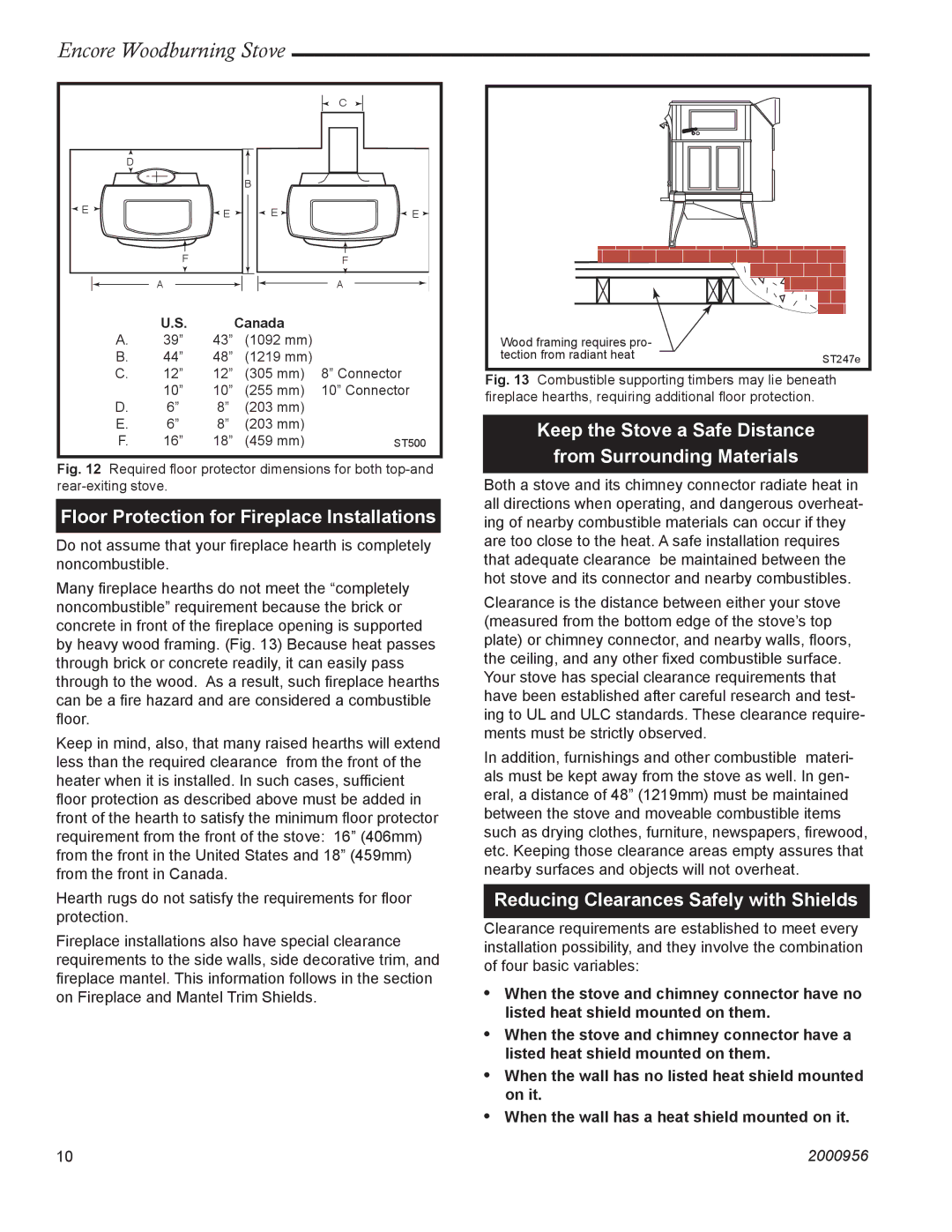
Encore Woodburning Stove
D
B
![]() E
E ![]()
![]()
![]() E
E ![]()
F
A
C
E ![]()
![]()
![]() E
E ![]()
F
A
U.S. Canada
A.39” 43” (1092 mm)
B.44” 48” (1219 mm)
C. | 12” | 12” | (305 mm) | 8” Connector |
| 10” | 10” | (255 mm) | 10” Connector |
D.6” 8” (203 mm)
E.6” 8” (203 mm)
F. | 16” | 18” (459 mm) | ST500 |
Fig. 12 Required floor protector dimensions for both top-and rear-exiting stove.
Floor Protection for Fireplace Installations
Do not assume that your fireplace hearth is completely noncombustible.
Many fireplace hearths do not meet the “completely noncombustible” requirement because the brick or concrete in front of the fireplace opening is supported by heavy wood framing. (Fig. 13) Because heat passes through brick or concrete readily, it can easily pass through to the wood. As a result, such fireplace hearths can be a fire hazard and are considered a combustible floor.
Keep in mind, also, that many raised hearths will extend less than the required clearance from the front of the heater when it is installed. In such cases, sufficient floor protection as described above must be added in front of the hearth to satisfy the minimum floor protector requirement from the front of the stove: 16” (406mm) from the front in the United States and 18” (459mm) from the front in Canada.
Hearth rugs do not satisfy the requirements for floor protection.
Fireplace installations also have special clearance requirements to the side walls, side decorative trim, and fireplace mantel. This information follows in the section on Fireplace and Mantel Trim Shields.
Wood framing requires pro- |
|
tection from radiant heat | ST247e |
|
Fig. 13 Combustible supporting timbers may lie beneath fireplace hearths, requiring additional floor protection.
Keep the Stove a Safe Distance
from Surrounding Materials
Both a stove and its chimney connector radiate heat in all directions when operating, and dangerous overheat- ing of nearby combustible materials can occur if they are too close to the heat. A safe installation requires that adequate clearance be maintained between the hot stove and its connector and nearby combustibles.
Clearance is the distance between either your stove (measured from the bottom edge of the stove’s top plate) or chimney connector, and nearby walls, floors, the ceiling, and any other fixed combustible surface. Your stove has special clearance requirements that have been established after careful research and test- ing to UL and ULC standards. These clearance require- ments must be strictly observed.
In addition, furnishings and other combustible materi- als must be kept away from the stove as well. In gen- eral, a distance of 48” (1219mm) must be maintained between the stove and moveable combustible items such as drying clothes, furniture, newspapers, firewood, etc. Keeping those clearance areas empty assures that nearby surfaces and objects will not overheat.
Reducing Clearances Safely with Shields
Clearance requirements are established to meet every installation possibility, and they involve the combination of four basic variables:
•When the stove and chimney connector have no listed heat shield mounted on them.
•When the stove and chimney connector have a listed heat shield mounted on them.
•When the wall has no listed heat shield mounted on it.
•When the wall has a heat shield mounted on it.
10 | 2000956 |
